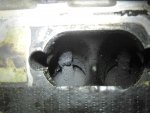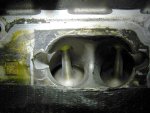You are using an out of date browser. It may not display this or other websites correctly.
You should upgrade or use an alternative browser.
You should upgrade or use an alternative browser.
2020 Ford Transit AWD
- Thread starter simple
- Start date
Scotty D
Active member
Billiebob has spoken. Go get your deposit back
I just tried but Ford has suspended all refunds until further notice.
Its seems that word of the humiliation the transit faced at the hands of Mr B Bob and spread all over the internet.
People are asking for refunds and Ford showrooms have totally emptied out.
This could be the final straw for the ailing company.
What a crazy weekend this turned out to be.
$2500 Ford Transit rebate if you own a GM van...
Been looking at GM box trucks lately.....
That may work:
"Customer must have leased the competitive vehicle for a minimum of 30 days prior to the sale date of the new VIN."
Will a title work? Or does it have to be a registration? I gave Ford a copy of my registration but I agree, will be looking for a cheap GM junk van if I just need to do some title work!
Check my previous link: https://www.rundeautogroup.com/runde_ford_rebt/2019-transit-connect-customer-cash-2-2-copy/
"
Not all customers will qualify for this factory incentive. Customers that currently Own a 1995 or newer or Lease a GM full-size van will receive Conquest Cash towards the purchase or lease of an eligible new vehicle. Current lease customers are not required to terminate their lease. Dealer must enter the entire customer’s competitive VIN along with the Make (i.e.Chevrolet) and Model (i.e.Impala) in Smart VINCENT claiming system or the claim will be reversed. Customer must have leased the competitive vehicle for a minimum of 30 days prior to the sale date of the new VIN. A competitive vehicle may be applied to one and only one new vehicle lease/purchase, even if two individuals are named on the title. Customer is NOT required to trade in their vehicle.
*Recreational vehicles including but not limited to: RV’s, snowmobiles and Ski-Doos are NOT considered eligible competitive make vehicles."
Will a title work? Or does it have to be a registration? I gave Ford a copy of my registration but I agree, will be looking for a cheap GM junk van if I just need to do some title work!
Well I just found one...but I am not sure if dealing with this guy is worth saving $2000....although I do share his frustration about dealing with Craigslist people.

Work van GMC 2002
Good work van 02 GMC Savana Custom LED lighting top, back and headlights High miles mostly Highway Only a couple issues driver side door won't lock And just need some brake work. No check engine...
boston.craigslist.org
"Don't come down here thinking you going to get a pristine van for less than $ $1,000. If this is not for you don't waste my time. Unbelievable but this is the type of society we're living in now a bunch of wussafide instant gratification idiots who want something for nothing. If you were born in the 80s or early 90s this probably means you. It's a van people not a friggin scooter don't come here offering me $400. Toughen the ********** up smarten the ********** up roll your sleeves up and put some work in. I'm no longer answering questions about the van due to dozens of people texting me. Ask me the same questions over and over if the ad is up it's available. Only question I will answer is what your address everything else will be ignored. As-is condition don't be a Jeff"
Good think I was born in the 70s....
Scotty D
Active member
Check my previous link: https://www.rundeautogroup.com/runde_ford_rebt/2019-transit-connect-customer-cash-2-2-copy/
"
Not all customers will qualify for this factory incentive. Customers that currently Own a 1995 or newer or Lease a GM full-size van will receive Conquest Cash towards the purchase or lease of an eligible new vehicle. Current lease customers are not required to terminate their lease. Dealer must enter the entire customer’s competitive VIN along with the Make (i.e.Chevrolet) and Model (i.e.Impala) in Smart VINCENT claiming system or the claim will be reversed. Customer must have leased the competitive vehicle for a minimum of 30 days prior to the sale date of the new VIN. A competitive vehicle may be applied to one and only one new vehicle lease/purchase, even if two individuals are named on the title. Customer is NOT required to trade in their vehicle.
*Recreational vehicles including but not limited to: RV’s, snowmobiles and Ski-Doos are NOT considered eligible competitive make vehicles."
That might be my fault , I called him up asking how well his van would do in a race with a jeep towing a teardrop trailer and he just blew up at me.
Pinnacle Campers
Chateau spotter
theron
Member
I’ve never owned a direct injection vehicle but it sounds like carbon build up becomes a issue with em, since fuel doesn’t get sprayed onto the valves, which in the past is what kept them clean
Sounds like the first thing a 3.5L ecoboost deserves is a catch can
The Ford Raptor has some plug and play solutions out there $400 already. I imagine you could home brew one up a lot cheaper too
A la:
Sounds like the first thing a 3.5L ecoboost deserves is a catch can
The Ford Raptor has some plug and play solutions out there $400 already. I imagine you could home brew one up a lot cheaper too
A la:
Last edited:
mk216v
Der Chef der Fahrzeuge
I’ve never owned a direct injection vehicle but it sounds like carbon build up becomes a issue with em, since fuel doesn’t get sprayed onto the valves, which in the past is what kept them clean
Sounds like the first thing a 3.5L ecoboost deserves is a catch can
The Ford Raptor has some plug and play solutions out there $400 already. I imagine you could home brew one up a lot cheaper too
A la:
Correct, carbon build-up on the backs of the valves is a widespread issues across all direct injection engines (DFI is more common than ever, in part to more stringent CAFE(MPG) standards, whether that be domestic, Asian import, European). Some manufacturers are now combating this with a DFI/PFI hybrid--sticking an add'l fuel injector above the valves to try to clean the backs of the valves a bit.
That was a well-done video, but while a catch can setup can help DFI engines in many ways, on the European side, I've also seen it cause many problems when catch can kits or DIY'ers get rid of some important factory crankcase breather components. First thing a DFI deserves in my professional automotive opinion are;
--oil changes with a high quality synthetic oil(oil which meets/exceeds factory manufacturer approvals) and factory filter, well before the manufacturer recommended mileage interval. Many manufacturers are now stretching recommended oil change intervals to as far as 20k!(for one thing, it makes a new vehicle appear to have a lower cost of ownership due to lower maintenance costs), and they're using lower quality "crap" oil to put more profits in their pocket. This combination heavily contributes to the breakdown of the oil, causing even more "filthy crap" to be "floating around" in the engine and crankcase breather system, which attaches to the backs of the valves, which over time build up enough to become large globs of carbon as he showed in the video. Enough of these carbon globbing and the valves may not seat fully, causing misfires and possibly flashing CEL. Change your oil at 5k (again, high quality full synthetic, factory filter) and you'll be better off with or without a catch can, than you'd ever be if you changed oil at 20k with low quality junk and yet had a superior catch can setup.
--when driving, once oil/coolant is up to temp, a bit of the old "Italian tune-up"; get the RPM's up and throttle down, helping blown some of this carbon build-up off of the valves. Yes, you'll see a large cloud of darker gray exhaust behind you, but that's how you know you're doing good work.
--remember to change your engine air filter at or before manufacturer recommendations (definitely before if you're driving on dusty terrain as we often do). A dirtier air filter will reduce engine performance, but can also lead to dirtier air being ingested into the engine, contributing to more "filthy crap" traveling through the engine.
NOTE; if the engine hasn't been maintained well and large carbon globs are present, we've had very good success on the European side with a professional walnut blasting procedure.
Before and after;


And as always, YMMV.
Last edited:
luthj
Engineer In Residence
BG products makes a interesting brew that is injected at low rates into the intake at idle. It rapidly breaks up the carbon. After the process the engine needs 2 oil changes to flush the gunk out. This is typically used on diesels which have swirl valves, but no reason it won't work on GDI engines.
theron
Member
Correct, carbon build-up on the backs of the valves is a widespread issues across all direct injection engines (DFI is more common than ever, in part to more stringent CAFE(MPG) standards, whether that be domestic, Asian import, European). Some manufacturers are now combating this with a DFI/PFI hybrid--sticking an add'l fuel injector above the valves to try to clean the backs of the valves a bit.
That was a well-done video, but while a catch can setup can help DFI engines in many ways, on the European side, I've also seen it cause many problems when catch can kits or DIY'ers get rid of some important factory crankcase breather components. First thing a DFI deserves in my professional automotive opinion are;
--oil changes with a high quality synthetic oil(oil which meets/exceeds factory manufacturer approvals) and factory filter, well before the manufacturer recommended mileage interval. Many manufacturers are now stretching recommended oil change intervals to as far as 20k!, and they're using lower quality "crap" oil to put more profits in their pocket. This combination heavily contributes to the breakdown of the oil, causing even more "filthy crap" to be "floating around" in the engine and crankcase breather system, which attaches to the backs of the valves, which over time build up enough to become large globs of carbon as he showed in the video. Enough of these carbon globbing and the valves may not seat fully, causing misfires and possibly flashing CEL. Change your oil at 5k (again, high quality full synthetic, factory filter) and you'll be better off with or without a catch can, than you'd ever be if you changed oil at 20k with low quality junk and yet had a superior catch can setup.
--when driving, once oil/coolant is up to temp, a bit of the old "Italian tune-up"; get the RPM's up and throttle down, helping blown some of this carbon build-up off of the valves. Yes, you'll see a large cloud of darker gray exhaust behind you, but that's how you know you're doing good work.
--remember to change your engine air filter at or before manufacturer recommendations (definitely before if you're driving on dusty terrain as we often do). A dirtier air filter will reduce engine performance, but can also lead to dirtier air being ingested into the engine, contributing to more "filthy crap" traveling through the engine.
NOTE; if the engine hasn't been maintained well and large carbon globs are present, we've had very good success on the European side with a professional walnut blasting procedure.
Before and after;
View attachment 564412
View attachment 564413
And as always, YMMV.
That’s a lot to unpack and I can’t comment on it all but it does look like the catch can system I linked to simply improve the PVC system, by not allowing the unwanted oil to return to the top, but still function as intended.
mk216v
Der Chef der Fahrzeuge
BG products makes a interesting brew that is injected at low rates into the intake at idle. It rapidly breaks up the carbon. After the process the engine needs 2 oil changes to flush the gunk out. This is typically used on diesels which have swirl valves, but no reason it won't work on GDI engines.
BG has many products before and after carbon issues; products to add to your fresh engine oil to minimize carbon deposits, and products such as you mention to add to existing/dirty oil to help remove deposits. Overall, good stuff. Currently using their 244 and 245 "fuel system cleaner" products for gas and diesel(respectively) at every major service interval.
mk216v
Der Chef der Fahrzeuge
That’s a lot to unpack and I can’t comment on it all but it does look like the catch can system I linked to simply improve the PVC system, by not allowing the unwanted oil to return to the top, but still function as intended.
Perhaps this catch can setup does (I haven't used it personally), but my point is that even if you use this catch can setup, and you were to use crappy quality oil, and change oil/filter every 20k, means the catch can setup is a small bandaid to ward off carbon. First/priority recommendation is to use high quality oil/filter and engine air filter, change them often, and don't be afraid to give the engine a workout to blow out some carbon. With this recipe, many (across all vehicle platforms) have seen no need to add a catch can setup.
luthj
Engineer In Residence
Lets not start an oil debate thread. But if you have details on "crappy" oil, like lab testing, etc. Please post up. All the testing I have seen indicates that its truly a challenge to find a bad common oil. There are superior ones, but few are bad. A good HD diesel synthetic is the best option to prevent soot buildup in the intake tracts, as the high detergent levels are good at suspending soot.
I have not seen any detailed testing which shows that catch cans reduce intake sooting. Typically they will only grab a small amount of oil from the PCV system. On turbocharged engines the spools seal will always leak some oil into the intake. No way to stop that.
I have not seen any detailed testing which shows that catch cans reduce intake sooting. Typically they will only grab a small amount of oil from the PCV system. On turbocharged engines the spools seal will always leak some oil into the intake. No way to stop that.
So what's your saying is that for an extended trip in Africa and South America, one would probably be better to get a Ford Transit with the standard 3.7 V6...
Similar threads
- Replies
- 9
- Views
- 4K
- Replies
- 0
- Views
- 690
- Replies
- 0
- Views
- 642
- Replies
- 12
- Views
- 4K
- Replies
- 27
- Views
- 5K

